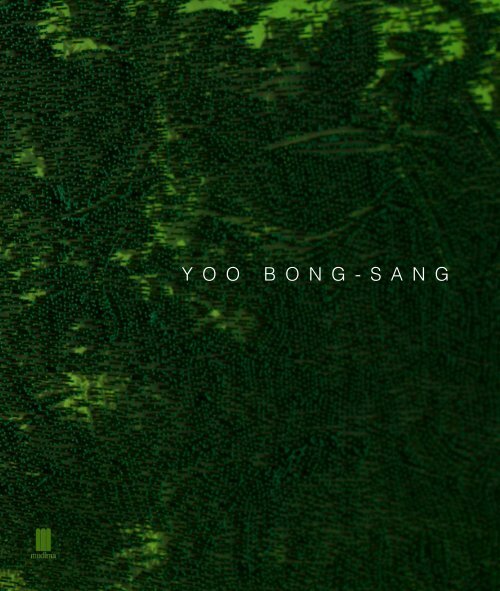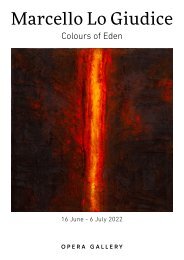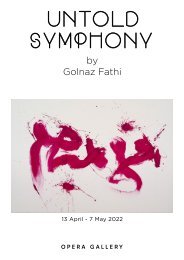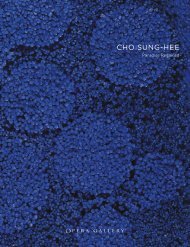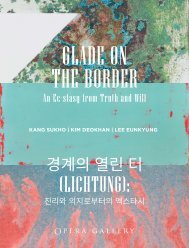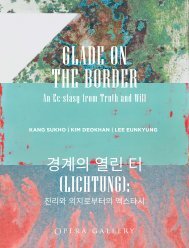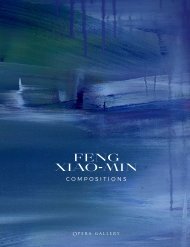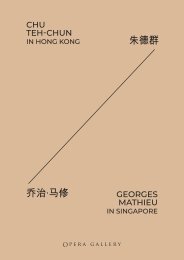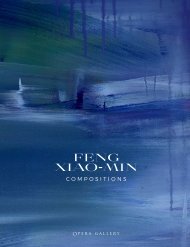yoo bon sang page 1-92
Create successful ePaper yourself
Turn your PDF publications into a flip-book with our unique Google optimized e-Paper software.
Y O O B O N G - S A N G
Y O O B O N G - S A N G
Published by Fondazione Mudima, Via Alessandro Tadino, 26, 20124 Milano, Italy in 2017<br />
© 2017:<br />
Paintings: YOO Bong-Sang<br />
Photography of Paintings:<br />
Portrait & Detail Photographs from the Studio:<br />
Words:<br />
Design: Joseph Clarke<br />
Cover Image: Detail from 'JJ20170808'<br />
All rights reserved. Except for the purposes of review, no part of this book may be reproduced, stored in a retrieval system, or transmitted,<br />
in any form or by any means, electronic, mechanical, photocopying, recording or otherwise, without the prior permission of the publishers.<br />
Produced with the kind support of Opera Gallery (operagallery.com)<br />
ISBN
C O N T E N T S<br />
ARTIST STATEMENT<br />
5<br />
ETERNITY EXISTING IN THE MOMENTARY<br />
8<br />
ARTIST INTERVIEW<br />
16<br />
WORKS<br />
24<br />
REALITY IS ALWAYS ON THE MOVE<br />
64<br />
BIOGRAPHY<br />
94
A R T I S T S T A T E M E N T<br />
My artworks begin with photography.<br />
When on my travels, I capture images that<br />
inspire my thinking about future pieces<br />
of work.<br />
My photographs are then adjusted to suit<br />
my intentions for the piece that I have<br />
in my minds eye. I adjust the size and<br />
contrasrt of the image accordingly before<br />
moving on to the next stage.<br />
The size and proportions of the<br />
sub-frames that I use are very important<br />
to the process of creating my pieces.<br />
These two criteria will determine the<br />
atmosphere and impact of the finished<br />
piece of work. I view this phase as the<br />
most delicate and painstaking. These<br />
supports are made from welded aluminium<br />
frame and plywood. They are made in such<br />
a way as to prevent distortion, and are<br />
substantial enough to support the weight<br />
of my primary medium.<br />
Having applied my photographic image<br />
to the support that I’ve made, I begin the<br />
paintstaking process of penetrating the<br />
surface with thousands of steel nails fired<br />
from a pressurised nail gun. This part of<br />
my process is simple and repetitive, it<br />
is ardous and time consuming, but it is<br />
something that cannot be avoided.<br />
In these works I use around 300,000<br />
nails on average, although that will vary<br />
depending on the size of the piece. The<br />
nails must be fired in straight and without<br />
error for the desired effect.<br />
The ocular effect is based on the density<br />
of nails, which responds to the underlying<br />
image; this is what ultimately becomes<br />
the final image. The end result is based<br />
on all these different tasks being carried<br />
out effectivelybut despite my knowledge<br />
of the processes required, my labours<br />
are no guarantee of the finished value or<br />
quality of the piece that I have produced.<br />
My simple hope is that rather than seeing<br />
the time that I’ve spent firing nails into<br />
a panel, it will be the atmosphere and<br />
ambience that I intended to create that<br />
will confront you first.<br />
YOO Bong-Sang, 2017<br />
5
ETERNITY EXISTING IN THE<br />
It is an irony that Yoo Bong-Sang's works,<br />
which are filled with light and agile<br />
imagary such as lights flashing along the<br />
horizon, bright areas in contrast to dark<br />
forest shadows and text written on paper,<br />
are in fact made of tens of thousands of<br />
stainless-steel pin nails driven into boards<br />
that weigh dozens of kilograms.<br />
His journey with his camera to collect<br />
images that trigger sympathy is no<br />
different from that of any other artist who<br />
travels with a drawing board, but the<br />
actual process to complete the work is<br />
led by a heaviness comparable to that<br />
of a labourer in a factory. After printing<br />
out the landscapes that inspired him and<br />
pasting them on to a wooden board, the<br />
artist hammers nails into the surface from<br />
top to bottom, sprays pigment on it, and<br />
then grinds the nails down with a grinder.<br />
The work process requires a strictness<br />
that does not allow the slightest of error.<br />
Through this method Yoo Bong-Sang fixes<br />
the momentary spontaneousness of the<br />
landscapes as eternity. He literally 'nails'<br />
each of the instances of rippling light<br />
that is discovered within mother nature<br />
onto his work. In that way he is similar to<br />
the Impressionists, the 'hunters of light',<br />
but unlike the Impressionist paintings, in<br />
which flatness was strictly maintained,<br />
Yoo's relief-like method, where numerous<br />
nails cover the surface, playing with light<br />
in a dimension that differs from painting.<br />
The dispersal of light, instantly reflecting<br />
off the surface of nature, is repeated in<br />
a different dimension as the highlights of<br />
the scene change as the points of view<br />
move according to the direction from<br />
which the nails were ground down.<br />
The moment is fixed for eternity, but<br />
another movement begins within the fixed<br />
internal. The nails create illusions as<br />
they are positioned as bright pixels or<br />
dots. Since the gravity of a pixel differs<br />
according to the size of the work, an<br />
optical illusion caused by the material<br />
itself and an illusion created by the<br />
representation of tones in the landscapes<br />
are mixed. The nails, which have five<br />
or six levels of density according to the<br />
work, rise up out of the dark tones of<br />
blue, purple and red in the background<br />
to serve as the highlights. The negative<br />
part of the picture-plane is covered with<br />
two or three colors of acrylic paint. All<br />
the images captured from locations in<br />
Korea or near the artist's studio in France<br />
include horizons in the landscapes, either<br />
latently or clearly. There are subject<br />
matter like text or the sea, which carry<br />
horizontal characteristics from the start,<br />
8
MOMENTARY<br />
BY LEE SEON-YOUNG<br />
as well as those that are cropped and<br />
spread out horizontally such as the<br />
forest images. The surface that gives an<br />
optical effect, and the monotone colors<br />
strongly evoke the sense of abstraction,<br />
but in the base of Yoo's works is the<br />
eternal source of art - nature. Even in the<br />
case of the works that do not rely on the<br />
printed-out photographs, the immanent<br />
rhythm of nature is evident. The natural<br />
rhythm caused during the work process<br />
reminds us of the landscape of a<br />
roaring ocean.<br />
The instantaneousness carried by light<br />
due to its way of existence consisting<br />
of particles and waves encounters with<br />
the instantaneousness of the camera,<br />
and the work materializes the moments<br />
of rapport with nature. Primarily, Yoo<br />
Bong-Sang's work is characterized by<br />
its non-continuity, which cuts off empty<br />
everyday continuation, and appeals to<br />
the momentary aspect of time in that it<br />
attempts to find newness and energy<br />
through the joining of time-space, which<br />
had been abundant at least for an instant.<br />
The aspect of time in his works is not<br />
something homogeneous, continuous or<br />
abstract, which can be captured through<br />
physical or historical coordinates, is<br />
linked to metaphysical events that<br />
are renewed as existence is launched<br />
every moment. In 'L'intuition de l'instant',<br />
Bachelard said that time is a moment,<br />
and what carries all the functions of time<br />
is the current moment. Based on this<br />
viewpoint, the past is empty just like the<br />
future, and the future is as dead as the<br />
past. From Bachelard's point of view, the<br />
moment does not carry continuity within<br />
it. It does not have momentum towards a<br />
single direction, or any other direction.<br />
Not having multiple aspects, it is the<br />
whole and it is singular. It is when time<br />
accepts pure homogeneity, and when it<br />
is understood within the solitude of the<br />
instant. But in Yoo's works, where the<br />
particles of light form a flow and there are<br />
continuously fluctuating perspectives, the<br />
moment contains continuity within.<br />
Yoo Bong-Sang focuses on a single<br />
moment that compresses life, but there is<br />
also a continuity that is avoided by the<br />
clear conscious thinking, as summarized<br />
by Cartesian philosophy. According<br />
to 'aesthetics of the instant', which<br />
stresses generation within purity and<br />
simplicity, or creation within solitude,<br />
the simple, the strong, the permanent<br />
and everything within us are products of<br />
the moment. Meanwhile, continuity is the<br />
dust of the instant. There is a dissipated<br />
9
heterogeneous characteristic that cannot<br />
be resolved. In Modernist thought,<br />
which praises the eternal presentness<br />
of painting - captured in an instant -<br />
continuity suggests impure opportunities,<br />
in which elements other than painting<br />
start to get mixed up. The works, which<br />
give up the purity of the painting media<br />
- Yoo Bong-Sang relies on a reel instead<br />
of an easel and works with a tacker<br />
instead of a brush - including the ones<br />
with illusions of nature, seem to deviate<br />
from the practices of Modernism, which<br />
adheres to the purity of the moment, but<br />
the alien materials introduced by the artist<br />
secure a sense of homogeneity no less<br />
than fine painting. Moreover, the physical<br />
properties and flat application of colors,<br />
which overwhelm the representational<br />
illusion, share Modernism's progressive<br />
direction towards the purity of painting.<br />
Yoo Bong-Sang's works are landscapes<br />
at a large scale, but at the same time<br />
they are also abstracts. He has merely<br />
discovered a point of balance in which<br />
landscape and abstract do not conflict<br />
with one another. The dialectical relation<br />
set between the continuity of life and<br />
the instantaneousness may be explained<br />
further through the flow of art history.<br />
In 'Art & Objecthood', Michael Fried noted<br />
the contrast between the presentness,<br />
instantaneity, and abstractness of<br />
Modernist abstraction, and the presence,<br />
continuity and objecthood of Minimalism.<br />
This concept of presentness refers to the<br />
powerful and abstract experience related<br />
to the work, which can be compared<br />
with pure perception that takes place<br />
in an extremely short instant. Quoting<br />
Diderot, he reminds us of the 'power to<br />
stop' or 'capability to instantaneously<br />
penetrate the spectator's heart and<br />
draw him/her in' of painting. Fried, who<br />
believed in the momentary power of<br />
painting, placed the instantaneousness<br />
of Modernist works, which are clear<br />
overall in every moment, in contrast with<br />
Minimalist continuity. According to Fried,<br />
thanks to the presentness of Modernist<br />
painting, the viewer experiences the work<br />
instantaneously. In this infinitely short<br />
moment, the viewer observes everything,<br />
experiences the depth and fullness of it,<br />
and gains eternal certainty from it. That<br />
is a short but truly satisfying experience.<br />
Fried, who thinks of art as purely visual,<br />
criticizes Minimalism, which emphasizes<br />
the temporality of perception. After<br />
Minimal, the aspect of time in fine art is<br />
stressed to a great degree, preventing us<br />
from looking at the works of art through a<br />
pure perspective of the present.<br />
Though the word Minimalism has elements<br />
that dismantle the form of painting itself,<br />
the 'minimal' way is often mentioned in<br />
daily language. In the works of the late<br />
90s, which were the beginning of the<br />
artist's works today, there were abstract<br />
works that arranged small picture-planes<br />
12
in a grid form, or used industrial material<br />
such as metal. These were 'minimal'.<br />
But now the 'minimal' aspect of Yoo's<br />
works is in the aspect of time. The<br />
procedural method of work - his work<br />
differs from those that can be produced<br />
freely, working on this part and then that<br />
part - and the horizontal composition<br />
dormant in the works contain a certain<br />
continuity of time, ultimately in the method<br />
of representing the light and darkness,<br />
which follows the gaze of the spectators.<br />
The instantaneousness that awakens the<br />
moment of clear consciousness and the<br />
continuous absorbtion that advances with<br />
the flow of time exist simultaneously. But<br />
in his work continuity does not take place<br />
through 'objects', which rely on uncertain<br />
unconsciousness, but through conscious<br />
'works'. The work process is strict and<br />
fulfills the density or qualitative standards<br />
as a high art form, and is also equipped<br />
with a self-sufficiency and self-identity<br />
regardless of the spectators' experiences.<br />
His work, which is made by hammering<br />
nails, could be a method that expands the<br />
act of completing a flat work of high purity<br />
and hanging it on the wall to infinity. But<br />
there is a self-betraying element in the<br />
attitude of trying to define something<br />
strictly. In retrospect, the impulse of early<br />
modernism, which attempted to combine<br />
the moment with eternity, was like that.<br />
Baudelaire, who declared the beginning of<br />
Modernism, said "the modern is something<br />
transient, something that disappears, and<br />
something accidental. This accounts for<br />
half of art, while the other half is eternal<br />
and something that does not change." The<br />
accidental aspect here reached its peak<br />
with Impressionism. This trend combined<br />
with progressivism of the modern times,<br />
which led to after Modernism, giving<br />
birth to the aesthetics of uncertainty and<br />
obscurity of Post-modernism. Amidst<br />
such trends, it seems that the eternity<br />
that Baudelaire mentioned together with<br />
spontaneity was oppressed, but if we<br />
recall the works of Neoclassicism seen in<br />
Post-impressionism, or those of Matisse<br />
or Cezanne, eternity was clearly an axis<br />
in modern and contemporary art together<br />
with spontaneity. The dialectics of eternity<br />
and the moment, which clearly existed in<br />
the beginning of Modernism, later flowed<br />
in a certain direction through various<br />
'isms' and aesthetic claims that had fallen<br />
into dogmatism. However, Yoo Bong-<br />
Sang's works, which insert continuity<br />
in instantaneousness through unique<br />
material and painterly methodology,<br />
have a vitality like the dance of floating<br />
particles, and yet also contain a<br />
mysterious tranquility like the 'Temple of<br />
Nature' (Baudelaire). It is a modernity with<br />
balance, where creation and structure<br />
coexist. In Yoo Bong-Sang's works, the<br />
instantaneous sparkling is no longer a<br />
"shaking reflection of the distant eternity,<br />
but becomes the very threshold of<br />
the eternal" (Henri Lefevre).<br />
13
14
ARTIST INTERVIEW<br />
Could you tell us about your quite unusual<br />
technique, based on the use of steel nails<br />
and reel?<br />
My recent work based on headless nails,<br />
and my previous pieces with polished<br />
nails, were created using a pneumatic nail<br />
gun over an underlying original design.<br />
Depending on that base design, I fire<br />
in the nails following the differences in<br />
density within the image and the process<br />
finishes with the application of colour.<br />
For the series using headless nails, I<br />
used stainless steel nails about as thick<br />
as needles. I add most of the nails in the<br />
darker parts of the base image. I then<br />
finish my works using different tones,<br />
sometimes applying the colour only to the<br />
ends of the nails.<br />
light makes waves over the tips of the<br />
nails is another aspect that viewers<br />
can experience. So since the nails are<br />
positioned differently in these two styles<br />
- in the darker parts of the image or the<br />
lighter parts - it would be fair to refer<br />
to the use of headless nails as ‘positive<br />
nailing’, and the use of headed nails as<br />
‘negative nailing’.<br />
If you want to talk about the ‘reel’,<br />
it’s there only to make it easier for me<br />
to use the pneumatic nail gun. The<br />
spring takes some of the weight of<br />
the nail gun, leaving me free to work<br />
more quickly.<br />
What is the origin of your nickname 'Nail'?<br />
In my previous work, I increased the<br />
density of nails in the lighter parts of the<br />
image, and then ground down their heads.<br />
To bring out the bright shine of stainless<br />
metal, I then used dark colours to<br />
create contrast.<br />
The ideal complement to these works is<br />
soft light at a fairly high level, and by<br />
changing viewpoint - by walking around<br />
the work or increasing and decreasing<br />
the viewing distance - the way in which<br />
I think it must be because I’ve used this<br />
nailing technique ever since 2000. People<br />
often remember me because of the fact I<br />
use nails.<br />
You have been living in France for more<br />
than twenty years; how has this double<br />
culture influenced your work?<br />
18 years to be precise. I don’t think that<br />
having lived in two countries as different<br />
16
from each other as Korea and France has<br />
influenced my work. Rather than affecting<br />
my work, it’s been a very good opportunity<br />
for me to observe the cultural differences<br />
between the East and West.<br />
The horizon and minimal landscapes of<br />
Chartres and the Beauce region where<br />
I used to live, I will cherish for a very<br />
long time.<br />
Cathedrals by Claude Monet?<br />
Some people may think that I have<br />
reinterpreted a work by Claude Monet;<br />
but the cathedral that appears in my work<br />
is Chartres, the city in which I lived. For<br />
someone like me, who wasn’t used to<br />
this kind of architecture, this cathedral<br />
seemed exotic, and with soft lighting I<br />
was able to obtain an image that became<br />
the source of my piece.<br />
How did this stated affiliation to Modernism<br />
start imbuing your work?<br />
Rather than draw inspiration from a<br />
particular style of art, I’m much more<br />
stimulated and influenced by moments<br />
from everyday life.<br />
Glaring sunlight and shadow, a forest<br />
in the rain or covered by heavy fog, a<br />
camera, the sleeve of a garment or a<br />
delicate hand, films, Edward Hopper,<br />
good coffee, good company, the smell<br />
of fresh washing, trees, cobblestone...<br />
I could go on to list a thousand sources<br />
of inspiration.<br />
How do you deal with the question of<br />
shades – created by nails and matter- in<br />
your works? Are they the starting point<br />
of your compositions, or rather do you<br />
compose with them as you go along?<br />
My pieces always begin with photography.<br />
I spend a lot of time waiting for the<br />
ideal light that will give my photographs<br />
a certain quality of shadow that I can<br />
work with in my pieces. I then choose<br />
those photographs that will be best for<br />
my underlying designs based on those<br />
shadows, which will determine the density<br />
of nails I use.<br />
Could you explain your re-interpretation<br />
of the famous Impressionist series of<br />
You use very specific framings, of a<br />
quasi-photographic nature. What is your<br />
17
connection to this medium?<br />
As I mentioned previously, my pieces<br />
always begin with photography. It’s a<br />
form of expression that’s very dear to<br />
me, and which has helped me develop<br />
my art. I use photography as my basic<br />
design tool, after having shaped it to suit<br />
my preferences, and I also make my own<br />
frames which, along with the photographs,<br />
are the starting point for my pieces. Having<br />
applied my selected photograph carefully<br />
to each frame that I have created, I’m<br />
ready to start the practical part of my<br />
creative process.<br />
Your works often hold a meditative or<br />
ethereal aspect, contrasting with the<br />
industrial connotation of the nails. Could<br />
you tell us about this dichotomy?<br />
I name my works purely to make it easier<br />
to classify them. The first letter refers to<br />
the name of the place or the first name<br />
of the person, and the figures that follow<br />
are simply the date on which I created the<br />
piece.<br />
Do you consider a progression of your<br />
technique for you coming creations, and<br />
notably via other tools, non-standard in<br />
painting?<br />
The use of new materials is something I<br />
constantly think about; so, if I can find a<br />
new material which is just as interesting<br />
as nails, then why not?<br />
It’s true that nails are hard, cold materials<br />
primarily designed for industrial use.<br />
My work is about using this hard, cold<br />
metal to produce a soft and delicate<br />
result. Sometimes, I feel that I wish to<br />
express and represent moments that<br />
cannot be frozen in time. I think that's the<br />
ironic flipside of my pieces.<br />
What would be your reading or how could<br />
we read interpret / explain the systematic<br />
character of your work titles?<br />
18
18
19
24
JAR20170818<br />
headless pins and acrylic on wood panel<br />
60 x 120 cm<br />
25
JJ20170808<br />
headless pins and acrylic on wood panel<br />
90 x 360 cm<br />
26
27
28
P20100427<br />
nails and acrylic on wood panel<br />
70 x 200 cm<br />
29
P1225<br />
nails and acrylic on wood panel<br />
70 x 200 cm<br />
30
31
32
P1212<br />
nails and acrylic on wood panel<br />
70 x 200 cm<br />
33
R20130404<br />
nails and acrylic on wood panel<br />
100 x 300 cm<br />
34
35
36
KJW20100<strong>92</strong>4<br />
nails and acrylic on wood panel<br />
80 x 200 cm<br />
37
HR20121108<br />
nails and acrylic on wood panel<br />
100 x 150 cm<br />
38
39
40
KJ20111215<br />
nails and acrylic on wood panel<br />
100 x 150 cm<br />
41
F20090202<br />
nails and acrylic on wood panel<br />
150 x 330 cm<br />
42
43
44
KJW20100806<br />
nails and acrylic on wood panel<br />
70 x 200 cm<br />
45
KJ20130107<br />
nails and acrylic on wood panel<br />
150 x 200 cm<br />
46
47
48
P20090<strong>92</strong>9<br />
nails and acrylic on wood panel<br />
130 x 130 cm<br />
49
JJ20170105<br />
headless pins and acrylic on wood panel<br />
150 x 100 cm<br />
50
51
52
KJW20101001<br />
nails and printed image on wood panel<br />
100 x 130 cm<br />
53
BB20090618<br />
nails and acrylic on wood panel<br />
110 x 150 cm<br />
54
55
56
R20100831<br />
nails and acrylic on wood panel<br />
50 x 150 cm<br />
57
M20090510<br />
nails and acrylic on wood panel<br />
110 x 300 cm<br />
58
59
60
M2004<br />
nails and charcoal powder on wood panel<br />
47 x 120 cm<br />
61
E20101001<br />
nails and acrylic on wood panel<br />
50 x 120 cm<br />
62
63
REALITY IS ALWAYS ON THE<br />
We already know that nails are for<br />
holding objects. What we did not<br />
know, however, is that they could<br />
also be used to hold light. Yoo Bong-<br />
Sang’s works prove to us the latter<br />
usage. Yoo Bong-Sang painted for<br />
a long time and found fascination in<br />
using nails as his material since 2000<br />
and this opened up a new horizon<br />
for him.<br />
Nails allowed Yoo Bong Sang to explore<br />
many themes ranging from almost<br />
abstract landscapes, forests, ocean<br />
surface to Cathedral of Chartres.<br />
Through nails, Yoo Bong Sang was<br />
able to view the conventional themes<br />
of paintings with a new angle and to<br />
create never-before-seen relief which<br />
was achieved by allocating shady or<br />
brilliant lots to his painting and by<br />
playing with reflection of light.<br />
It was, in fact, landscapes that led<br />
Yoo Bong Sang to nails. In the early<br />
90s, when he settled in France, he was<br />
inspired by the vast plain of Beauce. A<br />
distinctly marked skyline horizontally<br />
crossed his art works, evoking an image<br />
of a field in the lower part and the sky<br />
in the upper part through the use of<br />
monochromic contrast.<br />
When he began working with nails, Yoo<br />
Bong Sang applied the same principle<br />
and designated grey for the sky and<br />
nails for the ground.<br />
These nails that he drives in one after<br />
the other, in a row, randomly, blindly<br />
and in a mechanical way in the end<br />
create a rhythm that is reminiscent of<br />
sometimes of a writing or sometimes<br />
of waves. Yoo Bong Sang explored<br />
these two directions.<br />
For the first one, he bluntly pressed<br />
alphabet stamps onto lead plate. And<br />
for the latter direction, he quit using his<br />
habitual skylines to entirely cover the<br />
64
MOVE BY HENRI-FRANÇOIS DEBAILLEUX<br />
painting with nails which, according<br />
to their location and their density,<br />
evoke the movement of the sea and<br />
waves. Yoo Bong Sang noticed that<br />
his technique of using nails allowed<br />
him to leave the abstract field to<br />
move toward the representation<br />
of all choices of subjects. Without<br />
nails, he would never have made the<br />
cathedral paintings.<br />
Because head of nails look like pencil<br />
points, Yoo Bong Sang can draw<br />
everything he wants. He created<br />
brightness and darkness and light<br />
reflection by grinding down the<br />
head of the nails and orientating<br />
its inclination. The use of nails is<br />
therefore, in no way, an end in itself.<br />
Even without mentioning the details of<br />
many different and subtle processes<br />
of work, this material allows Yoo<br />
Bong Sang to create effects that<br />
he would not have obtained in any<br />
other way.<br />
One of the notable effects is the<br />
vibration of color and changes in<br />
tonality which occur according to<br />
different viewing angles. With changes<br />
in the point of view, picture does not<br />
stay the same, but it modifies itself<br />
under our eyes every time we move a<br />
step closer to it.<br />
When Yoo Bong Sang painted his still<br />
landscapes, he suspended the time.<br />
He created animation in every picture.<br />
He still expresses time but, now, he<br />
inserted the notion of movements and<br />
passages. In the end, his works remind<br />
us that reality is complex, changeable<br />
and always on the move.<br />
65
18
19
68
PAG20161122<br />
headless pins and acrylic on wood panel<br />
60 x 120 cm<br />
69
PAG20170615<br />
headless pins and acrylic on wood panel<br />
60 x 120 cm<br />
70
71
72
CATH20140404<br />
nails and acrylic on wood panel<br />
100 x 150 cm<br />
73
CATH20130<strong>92</strong>7<br />
nails and acrylic on wood panel<br />
100 x 150 cm<br />
74
75
76
CATH20091024<br />
nails and acrylic on wood panel<br />
130 x 130 cm<br />
77
PARIS20170<strong>92</strong>5<br />
headless pins and acrylic on wood panel<br />
100 x 150 cm<br />
78
79
80
HAN20170105<br />
headless pins and acrylic on wood panel<br />
80 x 200 cm<br />
81
82
ABOVE: VA20160606<br />
nails and acrylic on wood panel<br />
30 x 45 cm<br />
LEFT: SIE20170707<br />
headless pins and acrylic on wood panel<br />
150 x 100 cm<br />
83
JEAN20170822<br />
headless pins and acrylic on wood panel<br />
60 x 120 cm<br />
84
85
86
CY20150917<br />
headless pins and acrylic on wood panel<br />
50 x 120 cm<br />
87
Portrait HW20161009 for Human Presence I<br />
oil, acrylic, headless collage, pins and pencil acrylic on on primed wood wood panel panel<br />
<strong>92</strong> x 90 <strong>92</strong> x cm 175 cm<br />
88
89
90
YG20160816<br />
headless pins and acrylic on wood panel<br />
47 x 120 cm<br />
91
B I O G R A P H Y<br />
1983 B.F.A Seoul National University<br />
1987 M.F.A Seoul National University<br />
1990-08 Lived and worked in France<br />
SELECTED SOLO EXHIBITIONS<br />
2017 Fondazione Mudima, Milan<br />
Gallery PIU, Jeonju<br />
2015 Gallery D, Sockcho<br />
2014 Gallery Imazoo, Seoul<br />
2013 Gallery Bundo, Daegu<br />
2009 Gallery Hyundai, Seoul<br />
2009 YoungEun Museum of Contemporary Art, Gyeonggi<br />
2008 POSCO Art Museum, Seoul<br />
2004 Gallery IHN, Seoul<br />
2002 Gallery Johyun, Pusan<br />
2001 Gallery Seomi, Seoul<br />
1996 Gilbert Brownstone & Cie Gallery, Paris<br />
1994 Espace Bateau-Lavoir, Paris<br />
1993 ARTSENAL, Issy-les-Moulineaux, Paris<br />
1993 Espace Lucernaire, Paris<br />
SELECTED GROUP EXHIBITIONS<br />
2017 'Transcend Time', Gallery GRIMSON, Seoul<br />
'3 Artists', KWON, YOO, JEONG” KWONJINKYU<br />
Museum, Chuncheon<br />
'Conviction and Doubt-Trilogy', 021 Gallery, Daegu<br />
2016 'Lobbyist Show', KMCA, Seoul<br />
'The Great Labour', SOMA Museum, Seoul<br />
2015 'YOO Bong Sang', GUK Dae Ho 2 persons Exhibition,<br />
Gallery Song-A Dang, Seoul<br />
2014 'Audible Modern Art, Visible Classics', ILJU &<br />
SEONHWA Gallery, Seoul<br />
'Re-Imagination, Ilwoo Space, Seoul<br />
2013 'Open Mind', KOTRA, Seoul<br />
2012 'Unlimited, Unlimited - An Exhibition of 14 Korean<br />
Artists', Kwai Fung Hin Art Gallery, Hong Kong<br />
2010 'Contemporary Korean Artists' Cantor Fitzerald<br />
Gallery, Haverford, Pennsylvania<br />
2009 'The Great Hands', Gallery Hyundai, Seoul<br />
2006 'Frontières', Museum of Montparnasse, Paris<br />
'3 Korean Artists', Ibu Gallery, Paris<br />
2005 'The Seoul Art Exhibition', Seoul Museum of Art, Seoul<br />
'SONAMOU Paris-Seou', Korea Foundation, Seoul<br />
GRANTS<br />
2001 The Pollock-Krasner Foundation Grant<br />
COLLECTIONS<br />
Busan Museum of Art<br />
JEJU Museum of Contemporary Art<br />
Art Bank, National Museum of Modern and Contemporary Art Korea<br />
Pohang Museum of Steel Art<br />
Government Complex Sejong<br />
AMOREPACIFIC Museum of Art<br />
SeMA, Seoul Museum of Art<br />
YoungEun Museum<br />
YOO Bong-Sang is represented by Opera Gallery Worldwide


